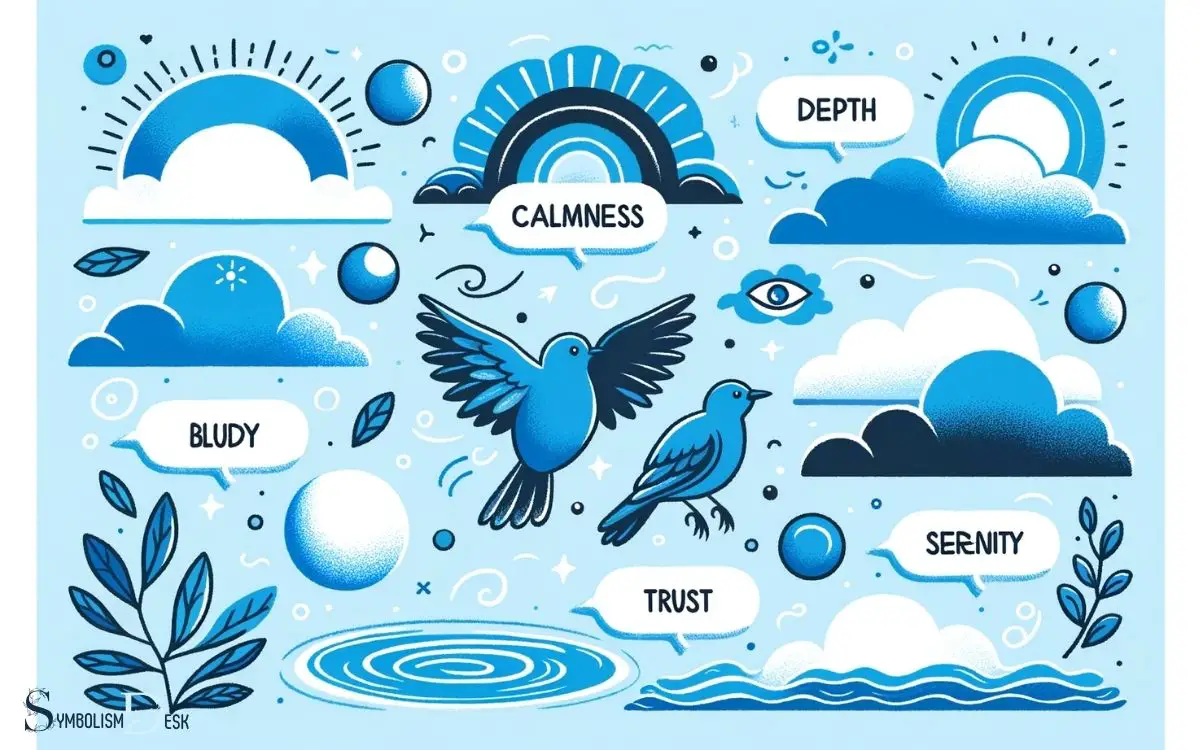What is the Symbolic Meaning of Blue? Intuition!
The color blue is rich in symbolic meaning, often associated with tranquility, depth, wisdom, trust, and stability. It also represents the sky and the sea, linking it to freedom, intuition, and imagination.
Across different cultures, blue can signify health, healing, and understanding, while in some contexts, it can convey sadness or aloofness. The significance of blue is multifaceted and can convey a wide array of emotions and ideas.
Blue’s symbolism varies globally and contextually:
- Tranquility and Calmness: Often used to create a peaceful atmosphere.
- Depth and Stability: Reflects reliability and conservatism.
- Wisdom and Trust: Institutions like banks and police uniforms utilize blue.
- Health and Healing: Associated with cleanliness and medical care.
- Intuition and Imagination: Linked to creativity and inspiration.
- Sadness and Aloofness: The phrase ‘feeling blue’ denotes sadness.
For example, a blue ribbon represents the best in show, blue in marketing is used to build customer trust, and in interior design, blue is used to create a serene and calming environment.
Embracing the essence of oceans and skies, blue’s symbolism permeates our world, influencing both our emotions and societal structures.

Key Takeaway
6 Aspects: Symbolic Meaning of Blue
| Symbolic Aspect | Blue’s Meaning |
|---|---|
| Emotion | Calmness, stability, sadness |
| Spirituality | Devotion, inspiration, meditation |
| Communication | Trustworthiness, reliability |
| Nature | Sky, ocean, water, depth |
| Culture | Royalty, wisdom, creativity |
| Psychology | Tranquility, peace, focus |
Cultural Symbolism of Blue
The cultural symbolism of blue varies across different societies, reflecting diverse meanings and associations with the color.
In many Western cultures, blue is often associated with calmness, stability, and depth. It’s frequently linked to feelings of trust, loyalty, and wisdom.
In contrast, some Eastern cultures associate blue with immortality, while in other parts of the world, it may symbolize healing or protection.
For example, in Hinduism, blue is associated with the god Krishna and signifies divine joy and love. In some African cultures, blue represents the sky, and it symbolizes spirituality and immortality.
The cultural symbolism of blue is rich and varied, demonstrating how a single color can hold different meanings and significance across the world.
Blue in Art and Literature
In art and literature, blue holds significant symbolic meanings and is often used to evoke emotions and convey themes ranging from tranquility to melancholy.
Artists and writers utilize the symbolism of blue to create a specific atmosphere or to represent various emotions within their work.
| Emotion | Description | Examples |
|---|---|---|
| Tranquility | Blue is used to evoke a sense of calm and peacefulness. | A serene blue sky in a landscape painting. |
| Sadness | It can represent sadness or loneliness. | A character’s blue attire in a novel depicting their melancholic state. |
| Serenity | Blue symbolizes inner peace and spiritual awakening. | A tranquil blue ocean in poetry. |
The use of blue in art and literature allows the audience to connect with the emotions and themes being portrayed, enhancing their understanding and emotional engagement with the work.
Spiritual Significance of Blue
Blue carries spiritual significance as it has been used to symbolize divine connections and spiritual enlightenment throughout history.
In various spiritual and religious traditions, blue represents the following:
- Divinity: Blue is often associated with the divine, representing the heavens and the presence of the divine in many cultures.
- Protection: It’s seen as a color that provides protection and wards off negative energies, bringing a sense of calm and peace to the spiritual realm.
- Wisdom: Blue is linked to wisdom and inner knowledge, signifying a deeper understanding of the spiritual truths and the universe.
These symbolic associations make blue a color of profound spiritual significance, eliciting feelings of tranquility, trust, and spiritual awareness.
Blue in Psychology and Emotions
Blue is more than just a color; it holds significant psychological and emotional meaning. The calming effect of blue has been well-documented, with studies showing that it can reduce stress and promote a sense of tranquility.
Additionally, it’s often associated with trustworthiness and dependability, making it a powerful symbol in various aspects of life.
Blue and Calmness
The color blue’s association with calmness is evident in its frequent use in various psychological studies and emotional assessments. Blue is often linked to feelings of tranquility and serenity, which has led to its widespread application in promoting relaxation and reducing stress.
The calming effect of blue on the mind and body has been observed in the following ways:
- Blue light exposure has been shown to regulate circadian rhythms and improve sleep quality.
- Surroundings with blue elements can help lower heart rate and blood pressure.
- In art therapy, the use of blue hues is employed to foster a sense of peace and emotional balance.
These findings underscore the significance of blue in promoting a sense of calmness and well-being in psychological and emotional contexts.
Blue and Trustworthiness
Associated with trustworthiness, blue has been extensively studied in psychology and emotions for its impact on perceptions and behavior. The color blue is often associated with qualities such as reliability, honesty, and dependability.
Research suggests that people tend to view individuals wearing blue as more trustworthy and credible. This perception can influence how individuals are perceived in various social and professional settings.
Moreover, blue is known to have a calming effect, which can further enhance the perception of trustworthiness. Understanding the psychological impact of the color blue on trust can be valuable in interpersonal interactions, business, and marketing.
Transitioning into the subsequent section about ‘blue in different societies’, it’s important to recognize that the perception of blue and its association with trustworthiness may vary across cultures and traditions.
Blue in Different Societies
In numerous societies around the world, blue holds diverse symbolic meanings and cultural significance. This color is interpreted differently across various cultures, and its significance can vary widely.
For example In Western cultures, blue is often associated with tranquility, trust, and stability. In Eastern cultures, particularly in China, blue symbolizes immortality and advancement.
In Middle Eastern societies, blue is linked to protection against the evil eye and is often used in amulets and talismans.
Understanding the cultural significance of blue in different societies helps to appreciate the rich tapestry of meanings associated with this color and how it influences various aspects of life, from art and fashion to spirituality and traditions.
Can the Symbolic Meaning of Green also Include Intuition, like Blue?
The symbolic meaning of green often encompasses growth, renewal, and harmony. While blue is associated with intuition, green is also considered a color of intuition, representing a deep connection to nature and the environment. In some cultures, green is believed to enhance intuitive abilities and promote a sense of balance and calm.
Contemporary Interpretations of Blue
Blue holds diverse symbolic meanings and cultural significance in contemporary society, reflecting its evolution and adaptation across different cultures and contexts.
In today’s world, blue is often associated with feelings of calmness, stability, and trust, making it a popular choice in corporate logos and branding.
It’s also linked to technology and innovation, with many tech companies using various shades of blue in their products and marketing materials to convey a sense of reliability and intelligence.
In terms of fashion and design, blue is often used to symbolize modernity and sophistication, appearing in everything from haute couture to home decor.
Additionally, in the realm of psychology, blue is seen as promoting mental clarity and emotional balance, further solidifying its contemporary significance.
Conclusion
While blue is often associated with feelings of calm and tranquility, its symbolic meanings vary across cultures and time periods.
From representing royalty and divinity to evoking feelings of sadness and melancholy, the color blue holds a complex and contradictory significance.
So next time you see the color blue, remember that its meaning isn’t always as clear as the sky on a sunny day.







